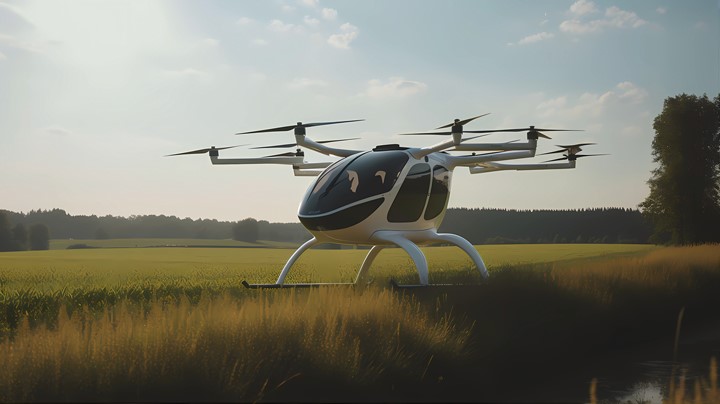Advanced Air Mobility Aircraft: An Effective and Accessible Transportation Option

1 Aug
2023
The Advanced Air Mobility concept involves a wide range of aircraft types, including electric vertical takeoff and landing (eVTOL) vehicles, hybrid-electric VTOL aircraft, autonomous drones, and other advanced aerial platforms. These vehicles are often constructed to function in urban areas and could be utilized as air taxis, cargo movers, medical transporters, or even in disaster response and relief activities. AAM airplanes frequently use electric motors or hybrid-electric propulsion systems to reduce pollution, noise, and operational expenses when compared to typical fossil fuel-powered engines.
As per the latest report by Allied Market Research, the airside services market is projected to cite the fastest growth throughout the forecast timeframe. Advanced Air Mobility envisions a future in which these aircraft play an important role in short- to medium-range transportation within urban and regional areas, supplementing ground-based transportation infrastructures. The integration of these aircraft into existing and future urban infrastructure, such as airspace management systems, vertiports (VTOL hubs), and regulations, is important for the effective implementation of AAM.
The demand for advanced air mobility aircraft is increased due to surging levels of road traffic congestion in urban areas, rising environmental concerns, technological advancements, improved transportation accessibility, and development of autonomous technology.
Cloud Software to Enable Advanced Air Mobility Network:
A Purdue University-affiliated startup will assist airport and vertiport operators as well as real estate developers trying to build advanced air mobility (AAM) technology at existing and new sites. ‘Aerovy Mobility’, a startup company established by Purdue University postgraduate students, is launching cloud-based software solutions for planning and operating infrastructure that charges electric airplanes with renewable energy.
According to Aerovy Mobility CEO Nick Gunady, advancements in battery energy technology have made electric propulsion both technically and commercially feasible. This comprises both urban air mobility, which uses electric vertical takeoff and landing aircraft, and regional air mobility, which can employ traditional aircraft layouts to cover longer distances.
Revolutionary Technological Advancements in Advanced Air Mobility Aircraft:
- Superior Design and Aerodynamics: AAM aircraft frequently have distinctive and unconventional designs that are ideal for vertical flight and urban operations. Aerodynamic innovations are required to maintain stable flight and lower drag, which contributes to improved energy efficiency.
- Electric and Hybrid-Electric Propulsion: An important focus of AAM aircraft development is on electric and hybrid-electric propulsion systems. While compared with typical combustion engines, these systems emit fewer pollutants, produce less noise, and can be more environmentally friendly. Battery technology and electric motor efficiency advancements have been important in enabling electric vertical takeoff and landing (eVTOL) aircraft.
- Air Traffic Management Integration: Developers are working on solutions that will enable the safe and efficient integration of AAM operations into existing airspace.
- Lightweight Materials: The use of innovative lightweight materials, such as carbon composites and advanced alloys, has become more common in AAM aircraft design. These materials reduce the overall weight of the airplane, resulting in improved energy efficiency and increased payload capacity.

Koyel Ghosh
Author’s Bio- Koyel Ghosh is a blogger with a strong passion and enjoys writing in miscellaneous domains, as she believes it lets her explore a wide variety of niches. She has an innate interest in creativity and enjoys experimenting with different writing styles. A writer who never stops imagining, she has been serving the corporate industry for the last five years.
Avenue: Entire Library membership of Allied Market Research Reports at your disposal
- Avenue is an innovative subscription-based online report database.
- Avail an online access to the entire library of syndicated reports on more than 2,000 niche industries and company profiles on more than 12,000 firms across 11 domains.
- A cost-effective model tailored for entrepreneurs, investors, and students & researchers at universities.
- Request customizations, suggest new reports, and avail analyst support as per your requirements.
- Get an access to the library of reports at any time from any device and anywhere.
Related Post
-
How are Submarine Cables Transforming Global Connectivity with Enhanced User Experience?
-
Endoscopy Procedures: Transformations in Techniques and Applications
-
AI-Powered Video Analytics: How the Product Actually Works for enterprises
-
Painting Robots: Transforming Precision Coating and Creative Applications
-
Innovations in Pharmacovigilance Systems Advancing Patient Safety
-
Understanding Edge Security: Keeping Data Safe Near the Source
-
Exploring the Use and Advancements of 3D Laser Scanners in Professional Applications
-
Reinforcing Industrial Controls with Smarter Tools and Training








